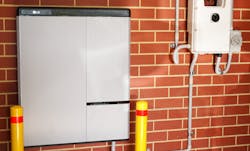Dropping Battery Costs, Savings Potential Drive Behind the Meter Energy Storage
There is economic potential for up to 490 GWper hour of behind-the-meter battery storage in the United States by 2050 in residential, commercial, and industrial sectors, or 300 times today's installed capacity. But only a small fraction could be adopted by customers, according to the National Renewable Energy Laboratory's Storage Futures Study.
"By implementing new battery capabilities in our model, we were able to do scenario comparison that revealed battery cost and the value of backup power are important drivers of distributed storage deployment," said Ashreeta Prasanna, lead author of the NREL technical report, Distributed Solar and Storage Outlook: Methodology and Scenarios.
The study provides one of the first published estimates of distributed battery storage deployment. The NREL team of analysts—also including Kevin McCabe, Ben Sigrin, and Nate Blair—modeled customer adoption of battery storage systems coupled with solar photovoltaics (PV) in the United States out to 2050 under several scenarios. The results can help inform planning for technical grid infrastructure to capture the benefits and mitigate the challenges of growing distributed electricity generation.
A widespread transition to distributed energy resources (DERs) is taking place. Households and businesses around the world are adopting DERs to lower their energy bills and curb carbon emissions. Local policymakers have set ambitious energy and climate goals; grid resiliency is a growing concern due to climate change and weather disasters; and more communities face high energy burdens.
In addition, Federal Energy Regulatory Commission Order 2222 enables DERs to participate alongside traditional energy resources in regional organized wholesale markets.
All these factors have contributed to a rise in DER deployment, including batteries. With declining battery storage costs, customers are starting to pair batteries with distributed solar. Behind-the-meter battery capacity totaled almost 1 gigawatt in the United States by the end of 2020, according to Wood Mackenzie.
While DERs offer many benefits to customers and the grid, like peak load shifting, integrating these resources into the power system presents complex challenges for electric utilities. "The transmission system wasn't designed with distributed generation in mind," said Ben Sigrin, coauthor of the report. "Projected DER adoption potential can provide a window into distributed generation and help inform future power system planning."
NREL's open-source Distributed Generation Market Demand (dGen) model simulates customer adoption of distributed solar, wind, and storage using a bottom-up, agent-based approach and spatially resolved data.
For this phase of the Storage Futures Study, the model was modified to simulate the technical, economic, and market potential of behind-the-meter battery storage.
dGen interoperated with NREL's System Advisor Model (SAM), which simulates the performance and efficiency of energy technologies, including cash flow analysis to calculate payback periods—an important consideration in a customer's decision to adopt a technology.
By interfacing with SAM, dGen modeled the cost-effectiveness and customer adoption of PV-plus-battery storage systems for residential, commercial, and industrial entities in the United States with different technology costs, storage valuation, incentives, and compensation. The resulting upper and lower bounds of adoption revealed what customers consider most in their decisions.
Across all 2,050 scenarios, dGen modeled economic potential for distributed battery storage coupled with PV. Scenarios assuming modest projected declines in battery costs and lower value of backup power show economic potential for 114 gigawatts of storage capacity—a 90-times increase from today. When battery costs reduce and the value of backup power doubles, the economic potential increases to 245 gigawatts.
However, only 7% of the estimated capacity is adopted by customers. The difference is largely due to the long payback period for distributed PV-plus-battery storage systems, which averages 11 years for the residential sector, 12 years for the commercial sector, and 8 years for the industrial sector in 2030.
Modeled deployment varies by location based on specific rate structures or incentive programs but is generally driven by battery cost and the value of backup power. Similar trends are seen on the national scale, where lower battery costs and high backup-power value increase deployment.
